May 31, 2023
Through photographs, magazine articles, and newspaper clippings, this blog post provides a glimpse into the remarkable family of Georgetown’s “Second Founder,” Patrick F. Healy, S.J. This archival collection was recently reorganized, and a new online finding aid is available.
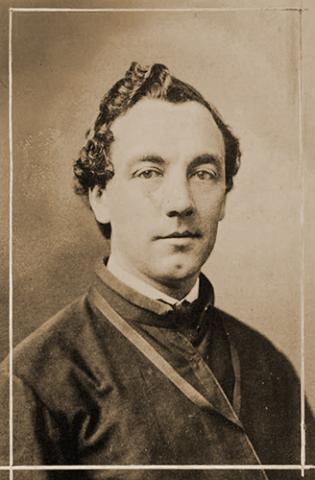
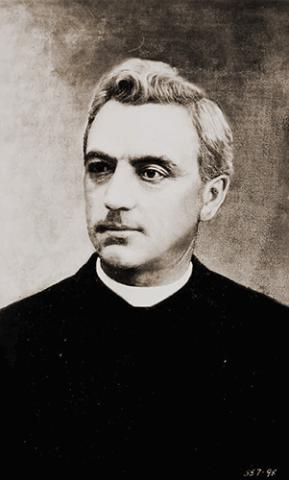
Patrick F. Healy, S.J. in 1873 and in 1882; Patrick F. Healy, S.J. Papers, Box 2, Folder 8
Patrick Francis Healy, S.J. was the 29th President of Georgetown, in office from 1873 to 1882. Celebrated for his ambition and vision, he is credited with transforming Georgetown into a modern university. Remarkably, Patrick Healy was also born legally enslaved. His father, Michael, was a plantation owner and slaveholder in Georgia; his mother, Eliza, was Michael’s property. In 1829, Michael and Eliza entered a common law marriage to circumvent anti-miscegenation laws. They went on to have ten children; Patrick was the third.
Barring formal emancipation, which Georgia law prevented, Michael and Eliza sought to safeguard their children from slavery. The siblings, many of whom were eventually able to “pass” for white, were educated in the North. As they came of age, Catholic religious life offered additional possibilities for protection. Patrick entered the Jesuit order. His brothers James and Sherwood were both ordained as priests; James became the Bishop of Portland, Maine, and Sherwood the Rector of Boston’s Cathedral of the Holy Cross. Patrick’s sister, Eliza, entered the Congregation of Notre Dame, serving as Mother Superior in several convents, and his other two sisters, Martha and Josephine, also spent time in religious orders.
Patrick Healy (1834-1910)
The two photographs, above, were taken at the start of Patrick Healy’s tenure as President of Georgetown in 1873, and at its culmination in 1882. After an extremely productive period of service, Healy resigned from the presidency due to poor health. These images document a striking change in his physical appearance over the ten years of his service.
Although the Jesuit community was aware of his racial background, Patrick Healy was largely successful in presenting himself as a white man.
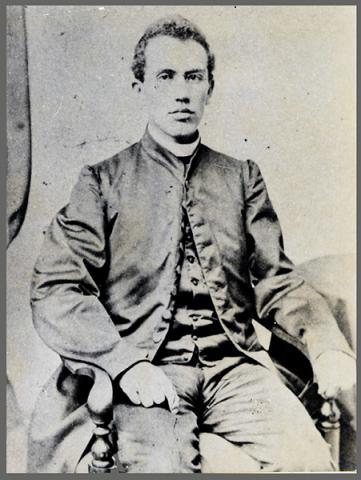
Alexander Sherwood Healy in undated photograph, Patrick F. Healy, S.J. Papers, Box 2, Folder 9
Sherwood Healy (1836-1875)
This undated photograph shows Sherwood, the fourth Healy son, as a young priest. A specialist in Gregorian chant, theology, and languages, he was a dedicated scholar and earned his doctorate in Paris. Unlike many of his siblings, however, Sherwood had difficulty concealing his racial identity; his contemporaries considered his African ancestry to be physically apparent. Although he became a Cathedral Rector in Boston, scholars believe his career may have been hampered as a result.

Captain Michael A. Healy in undated photograph, Patrick F. Healy, S.J. Papers, Box 2, Folder 9
Michael Healy (1838-1904)
Unlike his brothers, Michael Healy did not enter religious life. In 1864, he became a lieutenant in the U.S. Revenue Cutter Service (which would become part of the Coast Guard). He rose to the rank of Captain and was particularly known for his work in the waters surrounding Alaska, commanding the famous USS Bear. He is depicted here in his uniform.
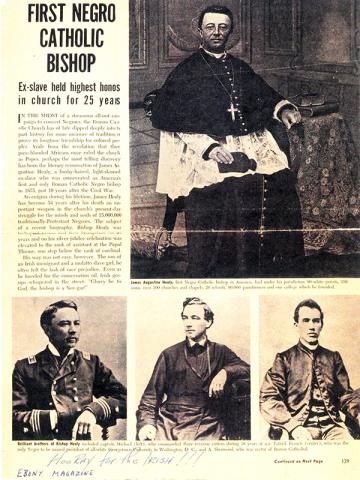
Bishop James A. Healy and his brothers in “First Negro Catholic Bishop,”
Ebony Magazine, Vol. 10, no. 1 (1954), page 129, Patrick F. Healy, S.J. Papers, Box 2, Folder 10]
James Healy (1830-1900)
This 1954 article from Ebony magazine celebrates James Healy and his 25-year service as Bishop of Portland, Maine. Though James, like his brothers, sought to keep his racial identity concealed, he was not always successful - there was some opposition to his installation as Bishop, for example, because of what one critic called his “indelicate blood.”
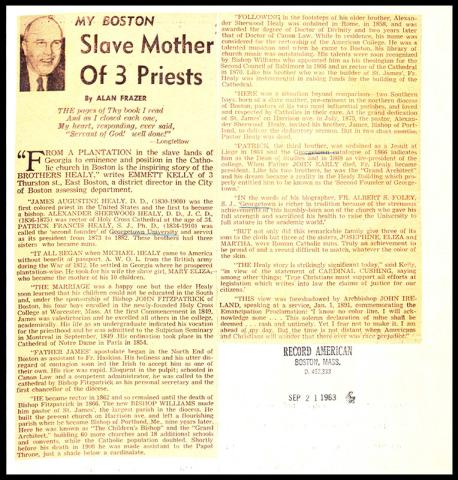
“Slave Mother of 3 Priests,” Record American (Boston, 1963, Patrick F. Healy, S.J. Papers, Box 2, Folder 10)
Race, Reckoning, and the Healy Family
In the second half of the 20th century, attitudes towards the Healy family’s “secret” were slowly starting to change. In 1954, the same year as the Ebony article, Albert S. Foley, S.J. published a biography of James Healy in which he discussed his parentage and legal status. There were occasional news stories about the Healys, such as this 1963 article entitled “Slave Mother of 3 Priests” in Boston’s Record American. In the 1970s, Georgetown University began claiming Patrick Healy as its first Black President; he was also acknowledged as the first Black American to earn a doctorate, as well as the first African American to enter the Jesuit order.
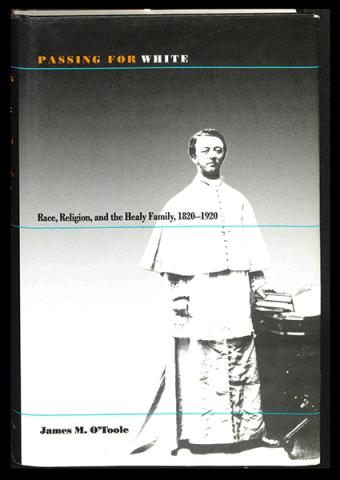
Passing for White: Race, Religion, and the Healy Family, 1820-1920 by James M. O’Toole
(Amherst: University of Massachusetts Press, 2002)
In 2002, historian James M. O’Toole published a detailed examination of the Healy family, Passing for White: Race, Religion, and the Healy Family, 1820-1920. O’Toole conducted research for his book using a wide array of sources, including materials from the Booth Family Center for Special Collections. James Healy is pictured on the cover.
—Cassandra Berman, Archivist for the Maryland Province Archives
